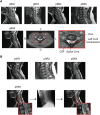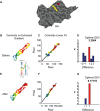Discontinuity of cortical gradients reflects sensory impairment
- PMID: 26655739
- PMCID: PMC4703006
- DOI: 10.1073/pnas.1506214112
Discontinuity of cortical gradients reflects sensory impairment
Abstract
Topographic maps and their continuity constitute a fundamental principle of brain organization. In the somatosensory system, whole-body sensory impairment may be reflected either in cortical signal reduction or disorganization of the somatotopic map, such as disturbed continuity. Here we investigated the role of continuity in pathological states. We studied whole-body cortical representations in response to continuous sensory stimulation under functional MRI (fMRI) in two unique patient populations-patients with cervical sensory Brown-Séquard syndrome (injury to one side of the spinal cord) and patients before and after surgical repair of cervical disk protrusion-enabling us to compare whole-body representations in the same study subjects. We quantified the spatial gradient of cortical activation and evaluated the divergence from a continuous pattern. Gradient continuity was found to be disturbed at the primary somatosensory cortex (S1) and the supplementary motor area (SMA), in both patient populations: contralateral to the disturbed body side in the Brown-Séquard group and before repair in the surgical group, which was further improved after intervention. Results corresponding to the nondisturbed body side and after surgical repair were comparable with control subjects. No difference was found in the fMRI signal power between the different conditions in the two groups, as well as with respect to control subjects. These results suggest that decreased sensation in our patients is related to gradient discontinuity rather than signal reduction. Gradient continuity may be crucial for somatotopic and other topographical organization, and its disruption may characterize pathological processing.
Keywords: fMRI; plasticity; somatotopy; topographic maps; whole-body representation.
Conflict of interest statement
The authors declare no conflict of interest.
Figures








References
-
- Penfield W, Boldrey E. Somatic motor and sensory representation in the cerebral cortex of man as studied by electrical stimulation. J Neurol. 1937;60:389–443.
-
- Penfield W, Rasmussen T. The Cerebral Cortex of Man: A Clinical Study of Localization of Function. Hafner; New York: 1950.
-
- Fox PT, Burton H, Raichle ME. Mapping human somatosensory cortex with positron emission tomography. J Neurosurg. 1987;67(1):34–43. - PubMed
-
- Nakamura A, et al. Somatosensory homunculus as drawn by MEG. Neuroimage. 1998;7(4 Pt 1):377–386. - PubMed
-
- Narici L, et al. Neuromagnetic somatosensory homunculus: A non-invasive approach in humans. Neurosci Lett. 1991;121(1-2):51–54. - PubMed
Publication types
MeSH terms
Grants and funding
LinkOut - more resources
Full Text Sources
Other Literature Sources
Medical

